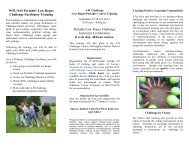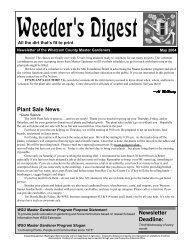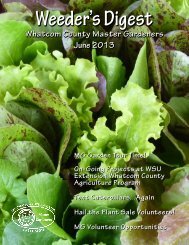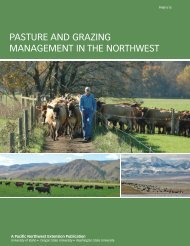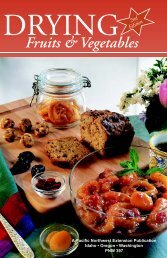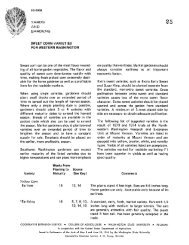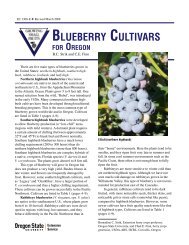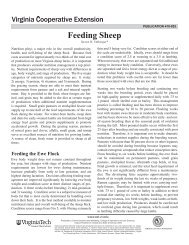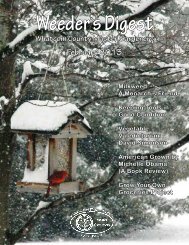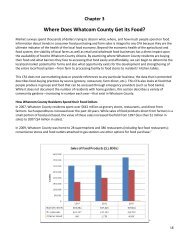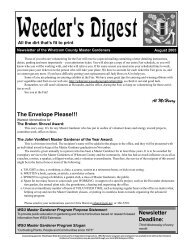Canning Vegetables - WSU Whatcom County Extension ...
Canning Vegetables - WSU Whatcom County Extension ...
Canning Vegetables - WSU Whatcom County Extension ...
You also want an ePaper? Increase the reach of your titles
YUMPU automatically turns print PDFs into web optimized ePapers that Google loves.
<strong>Canning</strong><br />
<strong>Vegetables</strong><br />
Food Preservation Home Studies Series • HS0006E
<strong>Canning</strong><br />
<strong>Vegetables</strong><br />
Theo Thomas and Holly Berry<br />
INTRODUCTION<br />
When you can vegetables at home, it is extremely<br />
important to do it safely. <strong>Vegetables</strong> are low-acid foods (pH<br />
above 4.6), susceptible to the growth of harmful bacteria<br />
unless they are processed correctly in a pressure canner.<br />
No shortcuts or variations are allowed! You must follow<br />
the procedures exactly. For more information, refer to<br />
<strong>Extension</strong> publication PNW0172, <strong>Canning</strong> <strong>Vegetables</strong>.<br />
TERMS YOU SHOULD KNOW<br />
LOW-ACID FOODS—have a pH above 4.6. These include<br />
vegetables as well as meats, poultry and fish. To<br />
can them safely, use a pressure canner.<br />
RAW/COLD PACK—food is packed raw and cold into<br />
jars, filled with boiling water and then processed.<br />
HOT PACK—food is heated through to boiling before<br />
being placed in jars, filled with boiling water and then<br />
processed.<br />
HEADSPACE—amount of space left between food or<br />
liquid and top of jar. If too little headspace, contents<br />
bubble out during processing. If too much, there may<br />
be excess air and the jar may not seal. Check recommended<br />
headspace for each food.<br />
1
PRESSURE CANNER—a special kettle that confines<br />
steam until it builds up pressure, thus raising the temperature<br />
above boiling.<br />
ACID CONTENT OF FOOD<br />
The acidity of a food is very important in home canning.<br />
Harmful bacteria can grow in foods that are low in<br />
acid. On the pH scale, which is how acidity is measured,<br />
low-acid foods have a pH above 4.6 and include vegetables<br />
as well as meats, poultry and fish. These foods can<br />
support the growth of bacteria that cause human diseases<br />
(like Clostridium botulinum).<br />
These bacteria are also quite heat-resistant. It takes temperatures<br />
higher than boiling to destroy them. The only way<br />
to obtain these temperatures is to use a pressure canner.<br />
In order to reach the 240˚F temperature needed, low-acid<br />
foods must be processed at 10 pounds in a weighted gauge<br />
pressure canner or 11 pounds with a dial gauge.<br />
ALL LOW-ACID FOODS MUST BE PROCESSED<br />
IN A PRESSURE CANNER SO THAT TEMPERA-<br />
TURES ARE SIGNIFICANTLY ABOVE THE BOILING<br />
POINT FOR A SPECIFIC TIME TO DESTROY HEAT-<br />
RESISTANT BACTERIA LIKE CLOSTRIDIUM BOTU-<br />
LINUM.<br />
High-acid foods (with a pH below 4.6) are sufficiently<br />
acid to inhibit the growth of harmful bacteria. These<br />
foods, including fruits, tomatoes and pickled products, can<br />
be safely processed in a boiling-water canner.<br />
BUYING A PRESSURE CANNER<br />
You must use a pressure canner to can vegetables. Its<br />
parts include:<br />
• BODY—a heavy kettle with a rack in the bottom and<br />
a cover that can be locked down.<br />
2
• SAFETY VENT—a petcock, safety valve or weight<br />
on the vent to control the escape of air or steam.<br />
• GASKET—a seal around cover to keep steam from<br />
leaking out.<br />
• PRESSURE GAUGE—registers the amount of steam<br />
in the canner and controls pressure. Two types are<br />
available:<br />
– DIAL GAUGE—the amount of pressure is shown<br />
on dial attached to canner cover. Look at the gauge<br />
needle to see that the pressure is maintained. It is<br />
fragile and must be checked yearly for accuracy<br />
(ask at local <strong>Extension</strong> office to find out where to<br />
have it checked).<br />
– WEIGHTED GAUGE—amount of pressure is<br />
regulated by setting control with holes for 5, 10 or<br />
15 pounds pressure on vent or placing weights on<br />
vent. Listen for jiggles to hear the pressure is maintained.<br />
Does not need to be checked since it has no<br />
breakable parts.<br />
Both are safe and accurate when used and cared for<br />
according to the manufacturer’s instructions.<br />
QUESTIONS ABOUT GAUGES<br />
WHY DO I HAVE TO OPERATE MY DIAL<br />
GAUGE CANNER AT 11 (INSTEAD OF 10)<br />
POUNDS PRESSURE?<br />
New research indicates that to reach the recommended<br />
240˚F temperature it takes 11 pounds on a dial gauge<br />
canner (from sea level to 2000 feet) and 10 pounds on a<br />
weighted gauge canner (from sea level to 1000 feet). Since<br />
it’s important to reach 240˚F to assure correct processing,<br />
low-acid foods that were processed at only 10 pounds<br />
pressure with a dial gauge would be underprocessed.<br />
3
IF I LIVE AT AN ALTITUDE ABOVE 2000 FEET,<br />
WHY DO I HAVE TO INCREASE THE PRESSURE<br />
WHEN USING A PRESSURE CANNER?<br />
As elevations increase, the atmospheric pressure is<br />
reduced. In order to achieve the correct temperature inside<br />
the canner, the pressure must be increased. Since we use<br />
11 pounds pressure at 0 to 2000 feet, it must be increased<br />
to 12 pounds at elevations from 2001 to 4000 feet. At<br />
4001 to 6000 feet, 13 pounds should be used. If you have<br />
a weighted gauge, the 10-pound weight is used at elevations<br />
from sea level to 1000 feet. Above 1000 feet, the 15-pound<br />
weight is used.<br />
HOW CAN I FIND OUT MY ALTlTUDE?<br />
Check with your local Soil Conservation office.<br />
DO I REALLY HAVE TO GET MY DIAL GAUGE<br />
TESTED YEARLY?<br />
Yes, a dial pressure gauge is quite fragile and should<br />
be checked at the beginning of the canning season (more<br />
often if it is used frequently or dropped). It is possible for<br />
the dial to read 11 pounds pressure, but not actually be operating<br />
at this pressure. If the gauge is inaccurate by more<br />
than 1 pound when tested, buy a new one.<br />
OTHER EQUIPMENT<br />
Except for needing a pressure canner instead of a<br />
boiling-water canner, all the rest of the utensils needed for<br />
canning vegetables are similar to those used for canning<br />
fruits.<br />
Standard canning jars<br />
• check for cracks or chips<br />
• use quart jars or smaller<br />
Standard lids<br />
• use a new lid each time<br />
• check manufacturer’s directions for pretreatment of<br />
lid before use<br />
4
Screwbands (rings)<br />
• discard any with rust or dents<br />
• after processed jars have cooled and you’ve tested<br />
the seal, remove the rings before storing jars<br />
Knives, cutting board, towels, funnel, jar lifter<br />
Bubble remover, a plastic knife or spatula to remove<br />
air bubbles before putting on lid<br />
Paper towels, to wipe jar rims before putting on lid to<br />
remove bits of food that might prevent a seal<br />
Timer. When weighted gauge reaches 10 pounds or<br />
dial gauge reaches 11 pounds, immediately set<br />
a timer for the required canning time. Adjust for<br />
altitude if using a weighted gauge pressure canner<br />
above 1000 ft. or a dial gauge above 2000 ft.<br />
EQUIPMENT QUESTIONS<br />
CAN I USE HALF-GALLON JARS FOR CANNING<br />
VEGETABLES?<br />
No, low-acid foods should never be canned in jars<br />
larger than a quart. No canning times have been developed<br />
for canning vegetables in half-gallon jars.<br />
WHAT SHOULD I DO IF I HEAR A JAR BREAK IN<br />
THE PRESSURE CANNER?<br />
Remove the canner from the stove irnmediately. Let the<br />
gauge drop to 0; open the canner and retrieve all the broken<br />
glass and food particles. Be sure no glass or food is lodged<br />
in the safety vent. Put fresh water in the canner and process<br />
the jars again for the full length of time specified.<br />
CAN I USE A PRESSURE SAUCEPAN FOR<br />
CANNING?<br />
No. Although this was done in the past by increasing<br />
the process time, it is no longer recommended. Newer research<br />
indicates this processing method is not completely<br />
safe.<br />
5
CAN I DO TWO LAYERS AT A TIME WHEN<br />
CANNING VEGETABLES?<br />
Yes. For two layers of jars it’s best to use a second<br />
rack to separate the layers. Process as usual.<br />
CAN A PRESSURE CANNER BE USED ON A<br />
SMOOTH-TOP RANGE?<br />
If your canner bottom is flat and in good contact with<br />
the range top, it may work successfully. Lay a ruler across<br />
the canner bottom; if it’s indented more than 1/8 inch, the<br />
canner is not flat enough to heat effectively. Check the<br />
owner’s manual of your range to determine if it may be<br />
used for canning.<br />
PRESSURE CANNING ERRORS<br />
Follow manufacturer’s instructions for your canner.<br />
Review them each time you use it. General directions are<br />
available in <strong>Extension</strong> publication PNW0172, <strong>Canning</strong><br />
<strong>Vegetables</strong>. Avoid these three possible errors.<br />
1. FAILURE TO EXHAUST<br />
You must vent the pressure canner for 10 minutes before<br />
building up the pressure to 10 pounds. This removes<br />
all the air. If there are air pockets trapped in the canner,<br />
the jars won’t get hot enough. All the air must be vented<br />
from the canner to insure the proper temperature and<br />
uniform steam pressure. It is recommended you manually<br />
vent even self-venting canners instead of trusting the<br />
automatic venting.<br />
2. PRESSURE ALLOWED TO FLUCTUATE<br />
Watch the canner continuously to be sure the pressure<br />
stays constant. If the pressure fluctuates, regulate it immediately<br />
by adjusting the heat. If the pressure falls below<br />
11 pounds on a dial gauge, or if the 10-pound weight on a<br />
weighted canner stops its rocking or jiggling, the jars must<br />
6
e reprocessed for the entire length of time. Fluctuating<br />
pressure may also cause liquid to be drawn out of the<br />
jars.<br />
3. PROCESSING TIME SHORTENED<br />
Never shorten the processing time recommendations<br />
for the specific vegetables you are canning. If foods are<br />
underprocessed, harmful bacteria may survive.<br />
BOTULISM<br />
The reason why there is so much emphasis on using<br />
up-to-date, reliable methods when canning vegetables is<br />
because if vegetables are improperly processed, Clostridium<br />
botulinum can survive to produce a deadly toxin<br />
in the sealed jar. Toxin can be present even though the<br />
canned vegetable looks, smells and tastes normal.<br />
Most of the outbreaks of food-borne botulism in<br />
Washington have been caused by improperly canned<br />
foods, primarily fish and vegetables such as asparagus,<br />
chili peppers, green beans, beets and corn.<br />
CONDITIONS THAT CAUSE BOTULISM<br />
• Botulism spores present. Since the bacteria are common<br />
in soil, spores may be on the vegetables.<br />
• Low acid level. Botulism grows at a pH range above<br />
4.6—this is the pH of vegetables; they can support<br />
botulism growth.<br />
• Temperatures lower than 240˚F. Botulism spores are<br />
extremely heat-resistant. A temperature of 240˚F,<br />
achievable only with a pressure canner, is required to<br />
destroy these spores.<br />
• Oxygen-free conditions. Botulism organisms cannot<br />
grow if air or oxygen is available. When a vegetable is<br />
canned, there is no oxygen in the sealed jar.<br />
7
BOTULISM POISONING<br />
SYMPTOMS:<br />
• They usually appear 12 to 36 hours after the<br />
contaminated food is eaten.<br />
• Common symptoms are blurred double vision, difficulty<br />
in swallowing and speaking and<br />
progressive respiratory paralysis.<br />
• May have nausea, vomiting and cramps.<br />
WHAT TO DO:<br />
• Contact physician and/or health department<br />
immediately.<br />
• Antitoxin is available but must be administered<br />
as soon as possible—recovery is slow; may be put<br />
on respirator.<br />
• Death from respiratory failure is possible.<br />
PREVENTION:<br />
• Follow reliable up-to-date canning instructions<br />
step by step.<br />
• Before using home-canned foods, automatically<br />
look for spoilage signs.<br />
• Never taste questionable foods.<br />
Although the Clostridium botulinum spore is heatresistant,<br />
the toxin it produces is destroyed by boiling.<br />
An added measure of safety is obtained if you boil<br />
home-canned vegetables for 10 minutes before eating at<br />
altitudes below 1000 feet. Add an additional minute of<br />
boiling time for each additional 1000-feet elevation.<br />
8
WHEN YOU PICK UP A JAR OF CANNED<br />
VEGETABLES:<br />
Automatically check for:<br />
• broken seal<br />
• bulging lid<br />
• mold, even a speck<br />
• small bubbles (gas)<br />
• spurting liquid or unusual pressure when the jar<br />
is opened<br />
• cloudy or yeasty liquid<br />
• unnatural or unpleasant odor<br />
• mushy, slimy food<br />
If a jar of food has any of these symptoms, consider it<br />
unsafe to eat. DO NOT TASTE—not even a little taste.<br />
Spoiled low-acid food may have different kinds of spoilage<br />
evidence or very little evidence. Therefore, all suspect<br />
containers of spoiled low-acid foods should be treated as<br />
having produced botulinum toxin and handled carefully in<br />
one of two ways:<br />
1. If the suspect glass jars are still sealed, label each<br />
jar “Danger: Do Not Eat.” Place the jars in a heavy<br />
garbage bag. Close and place the bag in a regular<br />
trash container or take it to a landfill.<br />
2. If the glass jars are unsealed, open, or leaking, they<br />
should be detoxified before disposal, using the following<br />
procedure:<br />
Carefully place the suspect containers and lids<br />
on their sides in an 8-quart volume or larger stock<br />
pot, pan, or boiling-water canner. Wash your hands<br />
thoroughly. Add water to the pot. The water should<br />
completely cover the containers by at least one<br />
inch. Avoid splashing the water. Cover the pot and<br />
heat the water to boiling. Boil 30 minutes to detoxify<br />
the food and the containers. Cool and discard<br />
9
the containers, their lids, and food in the trash or<br />
bury in soil.<br />
Thoroughly scrub all counters, containers, and<br />
equipment, including clothing and hands, that may<br />
have contacted the food or containers. Put sponges<br />
or washcloths used in the cleanup in a plastic bag<br />
and discard.<br />
PROBLEMS AND SOLUTIONS<br />
PROBLEM<br />
Off-odor<br />
(putrid,<br />
rancid, sour<br />
etc.)<br />
SOLUTION<br />
Discard carefully—could be dangerous.<br />
To avoid, wash vegetables well;<br />
process properly; don’t store at high temperatures.<br />
Cloudy<br />
Liquid<br />
White beets<br />
Brown corn<br />
Yellow<br />
Crystals<br />
in asparagus<br />
Discard carefully if food is soft and<br />
liquid is murky. Otherwise, food with<br />
cloudiness from starchy vegetables, minerals<br />
in water or anti-caking<br />
ingredients in salt may still be safe. Always<br />
boil 10 minutes before tasting.<br />
Safe. To avoid, use varieties best for canning;<br />
leave on the root and 1-inch stem<br />
when cooking prior to canning.<br />
Safe. To avoid, use corn of proper<br />
maturity and variety. Maintain<br />
constant pressure in canning.<br />
Safe. Rutin crystals form naturally. May<br />
also be gray or black.<br />
10
PROBLEM<br />
White<br />
crystals in<br />
spinach<br />
Jar does<br />
not seal<br />
SOLUTION<br />
Safe. Calcium oxalate crystals form naturally.<br />
If broken seal is detected within 24 hours<br />
of canning, food can be refrigerated and<br />
used, or reprocessed with new lid for full<br />
time. Discard carefully if more than 24<br />
hours have passed.<br />
OTHER QUESTIONS<br />
WHY CAN’T I JUST PROCESS MY VEGETABLES<br />
FOR 4 OR 5 HOURS IN A BOILING-WATER<br />
CANNER? THE LIDS SEALED.<br />
No! Discard vegetables processed in a boiling-water<br />
canner. They could be dangerous. To destroy Clostridium<br />
botulinum, vegetables must be processed at temperatures<br />
above that of boiling water. All you did was seal the bacteria<br />
in the jar and give them a perfect place to grow and<br />
produce deadly toxin. A sealed jar is not necessarily a safe<br />
jar.<br />
WHY NOT PROCESS VEGETABLES IN A<br />
BOILING-WATER CANNER, THEN BOIL<br />
BEFORE EATING TO DESTROY THE TOXIN?<br />
What if someone else cooks and doesn’t boil it completely?<br />
What if a child tastes before boiling is completed?<br />
What if the jar’s liquid contains impurities or other bacteria<br />
that cause spoilage? What if you forget? Play it safe.<br />
Can all vegetables in a pressure canner. Then, as an added<br />
safety precaution, boil them before tasting.<br />
WHY DO I ALWAYS LOSE LIQUID FROM THE<br />
JARS OF VEGETABLES AFTER PROCESSING?<br />
The most common cause is allowing the pressure to<br />
fluctuate during processing. It pulls the liquid right out<br />
11
of the jars. Do not turn the heat up and down too much.<br />
Other causes are filling jars too full, inadequate headspace,<br />
air bubbles left in jar, pressure too high, canner cooled too<br />
quickly, or vent opened before the pressure dropped. There<br />
are lots of possible causes. As long as the pressure did not<br />
fall below the recommendations for your gauge and altitude<br />
and you got a good seal, use the vegetables. Boiling 10<br />
minutes first is a good safety precaution.<br />
DO YOU HAVE A PROCESSING TIME FOR<br />
CANNING MASHED OR STRAINED PUMPKIN?<br />
Never can mashed or strained pumpkin or winter<br />
squash. It’s too thick for the heat to penetrate to the center<br />
and could be dangerous. However, you may cut these<br />
foods into 1-inch cubes and can. Check PNW0172,<br />
<strong>Canning</strong> <strong>Vegetables</strong>, for preparation and processing<br />
directions. You can mash the canned cubes before using<br />
if you wish.<br />
WHY CAN’T I FIND A PROCESSING TIME<br />
FOR CANNING CREAM-STYLE CORN IN<br />
QUART JARS?<br />
Cream-style corn is canned in half-pints or pints only.<br />
Larger jars cannot be used because heat penetrates this<br />
thick food very slowly. However, whole kernel corn may<br />
be canned in quart jars. If you raw pack whole kernel<br />
corn, pack it without shaking or pressing it down. It’s a<br />
starchy vegetable and when packed raw it will swell during<br />
processing. Check PNW0172, <strong>Canning</strong> <strong>Vegetables</strong>,<br />
for preparation and processing times. Also, note that extra<br />
headspace is needed.<br />
12
A FINAL WORD ON CANNING<br />
VEGETABLES SAFELY<br />
Since the major source of botulism poisoning is improperly<br />
processed home-canned foods, always follow<br />
these preventative measures:<br />
• Use up-to-date home canning instructions.<br />
Follow them step by step and adjust for altitude<br />
if necessary.<br />
• Be sure pressure canner is working properly.<br />
Have dial gauge checked yearly.<br />
• Vent canner 10 minutes to exhaust all air.<br />
• Follow the canning times for the vegetable you<br />
are canning including the same type of pack<br />
and same size jar.<br />
• Keep pressure steady for entire processing time.<br />
• Before using home-canned vegetables,<br />
automatically examine contents for possible<br />
spoilage.<br />
• Detoxify spoiled low-acid food in unsealed<br />
containers by placing jar, its contents and lid<br />
in hot water and boil for 30 minutes. Then,<br />
discard or bury.<br />
• Boil all home-canned vegetables (and other low-acid<br />
foods) 10 minutes. Add one minute boiling time<br />
for each additional 1000 feet.<br />
13
CANNING VEGETABLES<br />
CHECKLIST<br />
1. Select fresh, young vegetables.<br />
Wash well.<br />
Do not can over-mature, moldy or decayed<br />
food.<br />
2. Use reliable, up-to-date instructions.<br />
(PNW0172, <strong>Canning</strong> <strong>Vegetables</strong>)<br />
3. Use standard canning jars and lids.<br />
4. Process in a pressure canner.<br />
Follow manufacturer’s instructions.<br />
Vent canner 10 minutes.<br />
Keep pressure steady.<br />
Process full recommended time.<br />
5. Test for seal. Store in cool place.<br />
6. Examine closely before using.<br />
7. Boil all home-canned vegetables before<br />
tasting.<br />
8. Never taste questionable home-canned<br />
vegetables.<br />
14
CANNING VEGETABLES<br />
SELF-TEST<br />
Read each statement. If you think it is true, write a<br />
“T” in the “Before” column. If you think it is false, write<br />
an “F.” After reading and studying this publication, test<br />
yourself a second time using the “After” column. Check<br />
the inside back cover for the correct answers. If you still<br />
have questions, call your local <strong>Extension</strong> office.<br />
Before<br />
After<br />
1. A pressure canner is the only safe way to<br />
can vegetables.<br />
2. A dial gauge on a pressure canner should be<br />
checked before each use.<br />
3. The bacteria, Clostridium botulinum,<br />
produces a deadly toxin that is destroyed<br />
by boiling, even though the bacteria itself<br />
is quite heat-resistant.<br />
4. If you live at an altitude above 2000 feet,<br />
you must increase the processing time when<br />
canning vegetables.<br />
5. It is dangerous to process two layers of jars<br />
in a pressure canner.<br />
6. It is recommended you vent all pressure canners<br />
for 10 minutes to remove all air from<br />
the canner.<br />
7. If pressure falls below 10 pounds in a<br />
weighted gauge canner or 11 pounds in a<br />
dial gauge canner, you must start counting<br />
the processing time all over from beginning.<br />
8. Clostridium botulinum can grow in a sealed<br />
jar.<br />
9. As an extra safety precaution, home-canned<br />
vegetables can be boiled before tasting.
Theo Thomas is an <strong>Extension</strong> Home Economist at Washington State University; Holly<br />
Berry is an <strong>Extension</strong> Home Economist at Oregon State University. Reviewed by Val Hillers,<br />
<strong>Extension</strong> Food Specialist, Washington State University.<br />
<strong>WSU</strong> <strong>Extension</strong> bulletins contain material written and produced for public distribution.<br />
Alternate formats of our educational materials are available upon request for persons with<br />
disabilities. Please contact Washington State University <strong>Extension</strong> Communications and<br />
Educational Support for more information.<br />
You may order copies of this and other publications from <strong>WSU</strong> <strong>Extension</strong> Publishing and<br />
Printing at 1-800-723-1763 or http://pubs.wsu.edu.<br />
Issued by Washington State University <strong>Extension</strong> and the U.S. Department of Agriculture in<br />
furtherance of the Acts of May 8 and June 30, 1914. <strong>Extension</strong> programs and policies are<br />
consistent with federal and state laws and regulations on nondiscrimination regarding race,<br />
sex, religion, age, color, creed, and national or ethnic origin; physical, mental, or sensory<br />
disability; marital status or sexual orientation; and status as a Vietnam-era or disabled<br />
veteran. Evidence of noncompliance may be reported through your local <strong>WSU</strong> <strong>Extension</strong><br />
office. Trade names have been used to simplify information; no endorsement is intended.<br />
Revised September 1999. Subject code 665.<br />
HS0006



